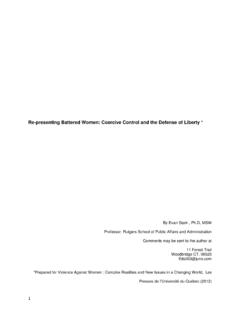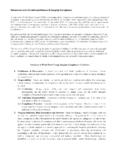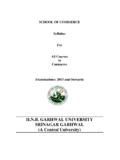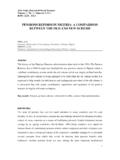Transcription of INTRODUCTION 1. RESEARCH METHODOLOGY 1.1. …
1 INTRODUCTION . 1. RESEARCH METHODOLOGY . The concept of the RESEARCH What are the new challenges women face today, how they cope with them, what they need in order to improve their situation and to realize successfully themselves at work, in pubic life, in the family. These are some of the major questions, this project tried to find answers of. It was conducted in Bulgaria, Kazahstan and Hungary with the UNIFEM's financial support. The goal of the project is to study the issues, expectations and new roles of women at work and in the family regarding the dynamics of the global transformations in all spheres of public life. It also aims to assist women's access to the globalizing labour market, as well as to contribute to improvement women's opportunities for a free choice and decent work and family realization.
2 For this purpose, a team of experts and highly qualified researchers conducted a large-scale in- depth survey, applying up to the modern world standards quantitative and qualitative methods. Within the project, a lot of empirical information was collected, systematized and analyzed, the main part of which is presented in this report. The received findings could be implemented in forming of data base on women's problems, improving the METHODOLOGY for collecting statistical information by gender, as well as for designing an employment policy accounting of the specific features of men and women, which may be implemented by both government and non-government organizations.
3 The concept of the survey was developed and specified through a series of discussions and actualizing of the main hypotheses. After a detailed analysis of theory, publications and available analyses on the topic, three main RESEARCH hypotheses have been formulated. The first hypothesis is that, the processes of worldwide globalization and economic, social and cultural transformations and reforms in the country change substantially the distribution of roles between men and women, adding more and more responsibilities for women. The second hypothesis is that, as a result of the hard transition to market economy, women have more limited access to the labour market, but at the same time they are more adaptive and combinative compare to men.
4 The third is that, in comparison with men, women are more strongly injured considering payment, employment, holding high posts, as well as distribution of household labour. Women are more likely to fall in the poverty trap than men are and all this requires the employment policies and the strategies for improving the quality of life in the country to be specified by gender. The RESEARCH team implemented a complex approach to verify the hypotheses which elaboration passes through the following stages: At the first stage, the concept of the survey was defined with the participation of authorized representatives of the three countries included in the project Bulgaria, Kazahstan and Hungary.
5 This was made on a three-day workshop in Plovdiv in February 2001. At the second stage, a consultative council to the main RESEARCH team has been formed, in which experts from the academic community, from different government and business institutions have been involved. The aim of the council was to contribute to the improving of work on the project at each phase. At the third stage, with the help of the consultative council, the RESEARCH methods were defined and the organization plan of the survey was approved. The team working on the project orientated toward conducting a large-scale survey on the theme, including quantitative and qualitative world standard methods.
6 At the forth stage, the RESEARCH tools for conducting of the qualitative phase of the survey were designed and discussed in-depth individual and group interviews, focus-groups, case-studies, content- analyses. At the fifth stage, tools for conducting of the quantitative RESEARCH were designed on the basis of findings from the previous, the qualitative phase, and from a systematization of statistical data. The sixth stage covered collecting, processing and analyses of the social information received from a national representative survey of the whole population in the country aged 18 and older. During the seventh stage of the survey, series of discussions and presentations have been organized, where the RESEARCH findings were presented and popularizied.
7 At a one-day workshop in November 2001, the main results of the survey were discussed with the consultative council and with other experts. In December, a four-day national dialogue has been organized, where a wider range of participants were invited with whom the RESEARCH findings and main conclusions, as well as the political recommendations toward the government and the authorities, were discussed1. At the beginning of March 2002, a special scientific and practical conference was organized by the Agency for social analyses (ASA) together with CITUB, where the findings of the project have been presented and discussed. The media has broadly presented the project and the received findings as well.
8 RESEARCH methods and approaches In order to attain the main objective of the survey, the RESEARCH team has orientated toward collecting quantitative and qualitative information through the following methods: Statistical data analysis The RESEARCH work started with a detailed desk RESEARCH on the available statistical data on women's status in the labour market over the period of active transformations in the country. Data from the National statistical institute have been processed and systematized considering activity rate, employment rate, unemployment rate by gender and in different dimensions (by level of education, age, family status) for the period 1993-20002.
9 The whole information was processied for the same period by gender and demographic indicators. Individual and group in-depth interviews with women from different social categories On the basis of the already outlined trends, the team designed the METHODOLOGY for the first (qualitative) phase of the survey. For specifying the main challenges women face, which to be measured later with quantitative methods, series of different types of qualitative surveys were conducted: - 11 in-depth interviews with experts from different institutions and with different roles in the process of transformations of society politicians on national and regional level, representatives of government and non-government organizations, of trade-unions and employers, of academic and scientific community.
10 - 7 focus-groups with representatives of employed and unemployed women, of young women before the start of their working career and with women before retirement, and with Romany women, as well, conducted in different settlements in the country (village, small town, big town). - Expert evaluations by specialists from the government and non-government sector, from trade unions, employers, university professors and researchers. 1. The lists with the names of the included in the Consultative council, as well as of the participants in the National dialogue and in the one-day workshop are given in Appendix 1 and in Appendix 2. 2. The main tables with statistical information for the pointed period are given in Appendix 5.








